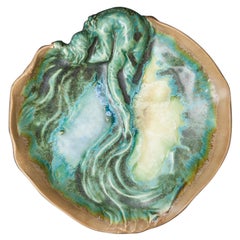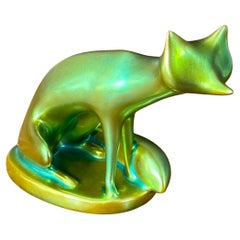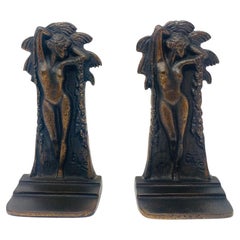Emile Jacob Furniture
The eldest of four, Emile Jacob was a self-taught artist and innovator in the ceramics industry. Along with his father and uncle, he opened tile manufacturing plants in Navilly, France in 1873 and Chapot in 1882, doing business under the company name, Jacob Freres (et fils). In 1886 he extended his enterprise to include stoneware production by opening E. Jacob & Cie, Compagnie des Gres Francais de Pouilly-sur-Saone. In this endeavor, he joined forces with Maurice Delafon in 1889 to form the company, Jacob-Delafon et Cie, manufacturers of kitchen and bathroom ceramics. They were awarded a gold medal that same year at the Exposition Universelle for sanitary ceramics.
Also exhibiting at the Paris Exposition under Jacob Freres (et fils), Emile Jacob submitted artistic ceramic ware produced at Navilly. A few years later in Paris in 1892, he exhibited artistic stoneware at the Exposition des Arts de la Femme. Soon after, he opened a ceramics store there located at 14 Quai de la Rapee which also housed ateliers for working wood, copper and pewter to complement his ceramic art. Never resting on his past accomplishments, Emile Jacob pushed for new research and new achievements. By the early-1890s, he added sang-de-boeuf glazes to his repertoire. Largely due to his firms’s commercial success, Jacob-Delafon expanded in 1898 by acquiring a factory in the Jura Department of France, a region known for marbre de Belvoye. The coarse limestone containing beige and pink-hued shells was rich in feldspar, a rock mineral necessary to make porcelain. Famous for what is known as their granit-porcelaine, the company once again took on a new name in 1899 to reflect the increasing breadth of its ceramic capability becoming Compagnie Ceramique de Pouilly-sur-Saone et Belvoye.
Always in upward trajectory, Jacob received a gold medal at Paris’ Exposition Universelle in 1900, and in 1908, he was made a Chevalier in the French Legion of Honor. Among many private collections, examples of Emile Jacob’s ceramic art can be found at the Musee des Arts Decoratifs, Paris.
Early 1900s French Art Nouveau Antique Emile Jacob Furniture
Ceramic, Porcelain
Early 20th Century Hungarian Art Nouveau Emile Jacob Furniture
Porcelain
1930s American Art Nouveau Vintage Emile Jacob Furniture
Iron
20th Century Danish Emile Jacob Furniture
Porcelain
Early 20th Century German Art Nouveau Emile Jacob Furniture
Porcelain
Early 20th Century European Art Nouveau Emile Jacob Furniture
Porcelain
1930s Art Nouveau Vintage Emile Jacob Furniture
Copper
Early 1900s French Arts and Crafts Antique Emile Jacob Furniture
Metal, Iron, Brass
1910s Austrian Art Nouveau Vintage Emile Jacob Furniture
Porcelain
1910s German Art Nouveau Vintage Emile Jacob Furniture
Porcelain
1910s German Art Nouveau Vintage Emile Jacob Furniture
Porcelain
Early 20th Century Czech Art Nouveau Emile Jacob Furniture
Porcelain
Early 1900s German Art Nouveau Antique Emile Jacob Furniture
Porcelain


